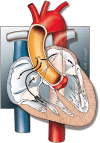Aorto-atrial fistula formation and therapy
- PMID: 31019791
- PMCID: PMC6462686
- DOI: 10.21037/jtd.2019.02.63
Aorto-atrial fistula formation and therapy
Abstract
Aorta-atrial fistulas (AAF) are a rare but complex pathological condition. These fistulas are characterised by aberrant blood flow between the aorta and either atrium. In the present manuscript, we present a comprehensive overview of the clinical characteristics, formation and treatment of this condition. A literature review was conducted using PubMed. Aorta-Atrial Fistula was used as the primary search term. The clinical presentation of AAF encompasses a wide range of signs and symptoms of heart failure including dyspnoea, chest pain, palpitations, fatigue, weakness coughing or oedema. Causes of fistulas can be congenital or acquired, whilst diagnosis is normally achieved via echocardiography or MRI. Due to the low incidence of AAF, no clinical trials have been performed in AAF patients and treatment strategies are based on expert opinion and consensus amongst the treating physicians. Uncorrected AAF may continue to impose a risk of progression to overt heart failure. The repair of an AAF can either be surgical or percutaneous. AAF is a relatively rare but very serious condition. Clinicians should consider the possibility of AAF, when a new continuous cardiac murmur occurs, especially in patients with a history of cardiac surgery or with signs of heart failure. Closure of the AAF fistula tract is generally recommended. Further studies are required to define optimal therapeutic strategies, but these are hindered by the rarity of the occurrence of this disorder.
Keywords: Aorta atrial fistula (AAF); surgery; treatment.
Conflict of interest statement
Conflicts of Interest: The authors have no conflicts of interest to declare.
Figures
References
Publication types
LinkOut - more resources
Full Text Sources


